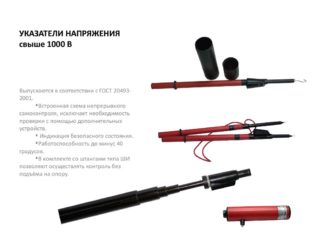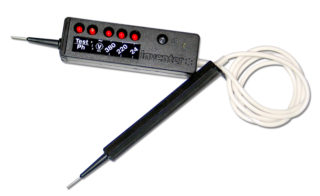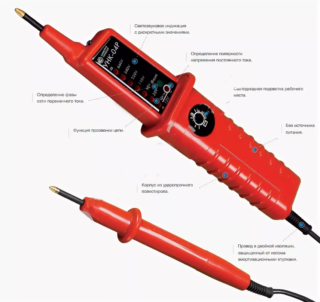Indicators, or voltage indicators, are portable electrical structures whose task is to check the presence or absence of voltage on live parts of the circuit. Most often, such a check is required before equipping the premises with a grounding system and before starting construction work.
Varieties of voltage indicators
Voltage indicators are divided into several types depending on the design features and the available functionality. Main classifications:
- By voltage power: indicator up to 1000V and over 1kV.
- By type of measurement current: devices designed for direct and alternating current.
- By the number of poles: single and double pole.
- By type of indicator: digital and using LED bulbs.
The non-contact voltage indicator is an innovative device that has become widespread due to its safe use in various, even adverse circumstances.
Device and principle of operation
Single pole devices
To calculate the presence of voltage, it is necessary to touch the live part to the live part. Grounding is provided on the human body when a finger touches the contact located on the pointer. The lamp starts to glow, because as a result of the above manipulations a small current is generated, about 0.3 milliamps.
As a rule, a low voltage indicator is made in the form of an ordinary flat screwdriver or fountain pen. The internal cavity of the housing is equipped with a neon or LED bulb and a resistor. In the lower part of the structure there is a probe and a spring, and in the upper part there is a contact area intended for touching with fingers.
Such a device is used to test alternating current, since at constant lighting element will not glow even when voltage is present. It is preferable to use a single-pole indicator for monitoring phase conductors, phases in the cartridge, socket, switch.
A single-pole indicator can be used up to 1000V without protective equipment, in particular rubber gloves.
Of the design flaws, it is worth highlighting low sensitivity. The presence of voltage is displayed only if its power is more than 90V.
Bipolar Indicator Designs
This design includes several individual parts, which are made of copper flexible insulated conductor and dielectric material. Both parts are interconnected.
To verify the presence or absence of voltage using this kind of indicators, you need to touch the two elements of the device between which voltage must pass. If there is voltage, a neon or LED light will burn under the influence of the current flowing through them.
The current strength is extremely small and is only a few milliamps. However, this value is sufficient for the lamp to produce a steady light signal. To limit the current strength, a resistor is connected in series with the lamp.
Based on this design, indicators are designed for measuring voltage values. They are equipped with a special LED scale, which has a graduation for specific voltage values.
Devices designed for voltages above 1 kV
 They work due to the effect of the glow of a neon lamp. It lights up at the moment when the capacitive current of the charging capacitor passes through its contacts.Parts are switched according to the serial connection diagram. Devices with similar design features are called high-voltage. Their task is to monitor the AC voltage. There are no sites for providing grounding through the human body.
They work due to the effect of the glow of a neon lamp. It lights up at the moment when the capacitive current of the charging capacitor passes through its contacts.Parts are switched according to the serial connection diagram. Devices with similar design features are called high-voltage. Their task is to monitor the AC voltage. There are no sites for providing grounding through the human body.
Each model has its own design features, but they all consist of the same set of elements: the working part, which includes a capacitor, a signal lamp, a housing; insulating part; pointer handle.
In order to ensure personal safety, you can use the high voltage indicator only with rubber gloves. Before using the device, you need to inspect it for damage, make sure that it works and gives a signal.
Control is carried out by means of a tray to the live parts of the probe device, which is under any circumstances energized. You can verify the performance using a megger or a source of increased voltage. The high voltage indicator can be checked in the garage as follows: carefully approach the indicator to one of the candles of a working engine of a car, moped or motorcycle.
For the purpose of safe use, the device must not be grounded, since the ground wire may accidentally touch live parts, which will result in electric shock. The high voltage indicator is capable of displaying data correctly even without a ground connection.
Universal devices
Such designs are used to control phase and zero, as well as to check the voltage and its value. The value for direct current reaches no more than 0.5 kV, and for alternating current it ranges from 12 to 750 volts. Devices are used for dialing connections in electrical communications.
The universal device can optionally be equipped with a digital display that displays approximate data. Despite the large number of advantageous features, the design has a low accuracy of readings. The main advantage is the lack of a power source.
Contactless pointers are necessary for calculating conductive conductors under voltage. They do not have to be on the surface, they can be hidden in the walls or ceiling. A feature of the device is susceptibility to an electromagnetic alternating field. Models are equipped with light and sound indication.
Terms of use
Before starting to use the device, each time it is important to inspect it for damage and insulation quality, and then make sure the indicator is working. It is necessary to touch the phase, knowing that it is energized. If the device is defective, an error will occur that will cause injury or short circuit. When using the indicator, it is important to be careful and careful, strictly follow the following rules:
- The pointer must comply with the parameters of the electrical network. To verify this is quite simple, you just need to familiarize yourself with the markings located on the device.
- One of the effective and easy to implement ways to avoid unwanted contact is to keep your free hand in your pocket, otherwise there is a chance of creating a closed loop for electrical discharge.
- During the performance check, you need to take a stable pose, eliminating the possibility of a fall or accidental contact of grounded conductors.
To minimize the likelihood of accidents, you must clearly follow all the rules and requirements of the work, as well as use personal protective equipment. Using single-pole devices, it is forbidden to use dielectric gloves.The finger of a specialist and the plate located on the handle of the indicator for grounding should be provided. If difficulties arise during the performance of work, it is better to contact the electricians with experience who will reduce the time spent and preserve health. You can find a specialist in a RES, an energy supply company or a housing office, they will provide all the necessary information.






